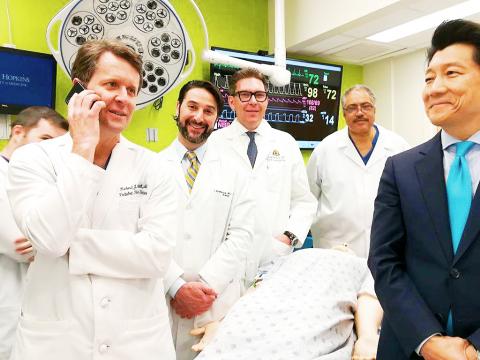Doctors at Johns Hopkins University School of Medicine on Monday said that they had performed the world’s first total penis and scrotum transplant on a US military serviceman who was wounded in Afghanistan.
The 14-hour operation was performed on March 26 by a team of nine plastic surgeons and two urologic surgeons led by Taiwanese-American W.P. Andrew Lee (李為平), a professor of plastic and reconstructive surgery and chairman of the school’s plastic and reconstructive surgery department.
“We are optimistic that he will regain near-normal urinary and sexual functions following a full recovery,” Lee told reporters.

Photo: Johns Hopkins School of Medicine / AFP
The patient was severely injured by a blast from an improvised explosive device in Afghanistan several years ago, Lee said.
The entire penis, scrotum without testicles and partial abdominal wall came from a deceased donor.
“It’s a real mind-boggling injury to suffer; it is not an easy one to accept,” the recipient said in a statement. “When I first woke up, I felt finally more normal.”
The man lost his testicles in the explosion and did not get them restored as part of his transplant.
“The testicles were not transplanted, because we had made a decision early in the program to not transplant germline tissue, that is to say not transplant tissue that generates sperm, because this would raise a number of ethical questions,” plastic surgeon Damon Cooney said.
Doctors said they are hopeful the man will be able to urinate with his penis in the coming weeks, and that he will eventually regain enough sensation to achieve an erection.
The extent of his sexual function will not be known for about six months, doctors said.
Lee was born in what was then-Kaohsiung County’s Gangshan Township (岡山) to a father serving in the Republic of China Air Force. He immigrated to the US when he was 15 to join an older brother and sister who had immigrated earlier.
He earned an honors degree in physics from Harvard and his medical degree from Johns Hopkins, where he also completed his general surgery residency and a microvascular research fellowship before completing his plastic surgery fellowship at Massachusetts General.
Initially specializing in hand surgery, he has been working on human-to-human limb transplantation since 1986. When he was chief of plastic surgery at the University of Pittsburgh Medical Center, he led a team that performed the first bilateral arm transplant in the US on an injured soldier.
Additional reporting by staff writer and CNA

A magnitude 7.0 earthquake struck off Yilan at 11:05pm yesterday, the Central Weather Administration (CWA) said. The epicenter was located at sea, about 32.3km east of Yilan County Hall, at a depth of 72.8km, CWA data showed There were no immediate reports of damage. The intensity of the quake, which gauges the actual effect of a seismic event, measured 4 in Yilan County area on Taiwan’s seven-tier intensity scale, the data showed. It measured 4 in other parts of eastern, northern and central Taiwan as well as Tainan, and 3 in Kaohsiung and Pingtung County, and 2 in Lienchiang and Penghu counties and 1

FOREIGN INTERFERENCE: Beijing would likely intensify public opinion warfare in next year’s local elections to prevent Lai from getting re-elected, the ‘Yomiuri Shimbun’ said Internal documents from a Chinese artificial intelligence (AI) company indicated that China has been using the technology to intervene in foreign elections, including propaganda targeting Taiwan’s local elections next year and presidential elections in 2028, a Japanese newspaper reported yesterday. The Institute of National Security of Vanderbilt University obtained nearly 400 pages of documents from GoLaxy, a company with ties to the Chinese government, and found evidence that it had apparently deployed sophisticated, AI-driven propaganda campaigns in Hong Kong and Taiwan to shape public opinion, the Yomiuri Shimbun reported. GoLaxy provides insights, situation analysis and public opinion-shaping technology by conducting network surveillance

Taiwan is gearing up to celebrate the New Year at events across the country, headlined by the annual countdown and Taipei 101 fireworks display at midnight. Many of the events are to be livesteamed online. See below for lineups and links: Taipei Taipei’s New Year’s Party 2026 is to begin at 7pm and run until 1am, with the theme “Sailing to the Future.” South Korean girl group KARA is headlining the concert at Taipei City Hall Plaza, with additional performances by Amber An (安心亞), Nick Chou (周湯豪), hip-hop trio Nine One One (玖壹壹), Bii (畢書盡), girl group Genblue (幻藍小熊) and more. The festivities are to

Auckland rang in 2026 with a downtown fireworks display launched from New Zealand’s tallest structure, Sky Tower, making it the first major city to greet the new year at a celebration dampened by rain, while crowds in Taipei braved the elements to watch Taipei 101’s display. South Pacific countries are the first to bid farewell to 2025. Clocks struck midnight in Auckland, with a population of 1.7 million, 18 hours before the famous ball was to drop in New York’s Times Square. The five-minute display involved 3,500 fireworks launched from the 240m Sky Tower. Smaller community events were canceled across New Zealand’s